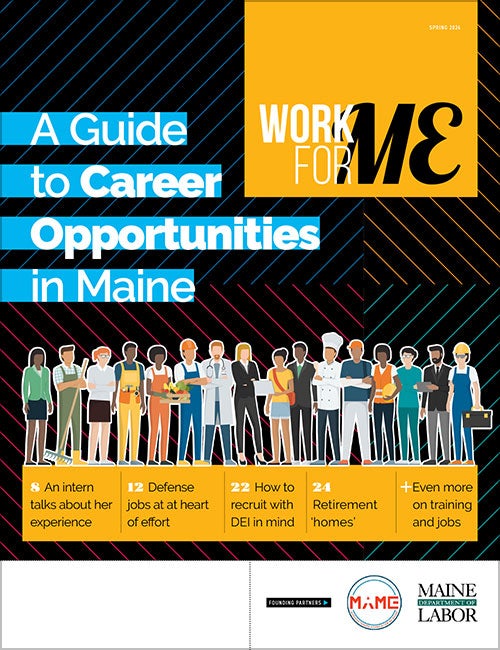Processing Your Payment
Please do not leave this page until complete. This can take a few moments.
- News
-
Editions
-
- Lists
-
Viewpoints
-
Our Events
-
Event Info
- Women's Leadership Forum 2025
- On the Road with Mainebiz in Bethel
- Health Care Forum 2025
- On The Road with Mainebiz in Greenville
- On The Road with Mainebiz in Waterville
- Small Business Forum 2025
- Outstanding Women in Business Reception 2025
- On The Road with Mainebiz in Bath
- 60 Ideas in 60 Minutes Portland 2025
- 40 Under 40 Awards Reception 2025
- On The Road with Mainebiz in Lewiston / Auburn
- 60 Ideas in 60 Minutes Bangor 2025
Award Honorees
- 2025 Business Leaders of the Year
- 2024 Women to Watch Honorees
- 2024 Business Leaders of the Year
- 2023 NextUp: 40 Under 40 Honorees
- 2023 Women to Watch Honorees
- 2023 Business Leaders of the Year
- 2022 NextUp: 40 Under 40 Honorees
- 2022 Women to Watch Honorees
- 2022 Business Leaders of the Year
-
-
Calendar
-
Biz Marketplace
- News
- Editions
- Lists
- Viewpoints
-
Our Events
Event Info
- View all Events
- Women's Leadership Forum 2025
- On the Road with Mainebiz in Bethel
- Health Care Forum 2025
- On The Road with Mainebiz in Greenville
- On The Road with Mainebiz in Waterville
- + More
Award Honorees
- 2025 Business Leaders of the Year
- 2024 Women to Watch Honorees
- 2024 Business Leaders of the Year
- 2023 NextUp: 40 Under 40 Honorees
- 2023 Women to Watch Honorees
- 2023 Business Leaders of the Year
- + More
- 2022 NextUp: 40 Under 40 Honorees
- 2022 Women to Watch Honorees
- 2022 Business Leaders of the Year
- Nomination Forms
- Calendar
- Biz Marketplace
November 26, 2007
Room and board | Colby College is the first Maine school to replace loans for state students, but it won't be the last
Starting next fall, Colby College will replace loans with grants for all Maine students, allowing them to finish their education with no debt. The Waterville college hopes the tuition break will boost enrollment of state residents from 10% to at least 12% of its student population.
"It's part of our heritage," says Stephen Heacock, Colby's spokesman, about the school's desire to attract more local students. "It is our home state. And Mainers have always done very well here."
Also, by cutting out loans ˆ even if it's only for a targeted demographic ˆ Colby is jumping on a trend coursing through college campuses right now. In early November, Williams College in Williamstown, Mass., announced it would throw out loans altogether for current and future students beginning next year. New Jersey's Princeton University, the leader of the pack, abolished loans in 2001, and since then has been followed by Amherst College in Amherst, Mass., and Davidson College in Davidson, N.C.
The Institute for College Access and Success, based in Berkeley, Calif., has identified 31 private and public schools that have pledged financial aid to help students avoid or reduce borrowing. The majority of these programs are, though, geared toward students with limited means. Wesleyan University in Middletown, Conn., for instance, is rubbing out loans for students with family incomes under $40,000.
"It is the 'in' thing to do," says Richard Vedder, director of the Center for College Affordability and Productivity, based in Washington, D.C. "It is a marketing advantage that the elite schools are using." He expects at some point most private schools will follow suit to avoid losing applicants.
Vedder also points out that many colleges needed to simplify their financial-aid offerings and demonstrate more awareness of how difficult it was for middle- to low-income students to afford pricey educations. "Sensitivity around loans is growing," he says. "Now [school officials] are reading all these horror stories about people getting into massive debt, and who want to go into the social services sector but can't make debt payments."
For a high school senior perusing private colleges, the costs might appear daunting. Colby's tuition this year, including room and board, is $46,000, which mirrors tuitions at similar elite schools across the country. The yearly price for Brunswick's Bowdoin College is $46,260, and Lewiston's Bates College costs $46,800. Tuitions in the last few years have been growing at an annual clip of roughly five percent. Meanwhile, many endowments across the country have been posting robust returns; some schools' funds grew by more than 20% for the 12 months through June, including Bates', Bowdoin's and Colby's.
As endowments have grown, critics have reproached wealthy schools for not spending more of their money to curtail rising tuitions. In response to the growing admonishment, as well as to bolster their public relations and adhere to an enlightened philosophy of education, private schools have been more aggressively reaching out to students from diverse economic backgrounds.
The five-percent rule
The U.S. Senate Committee on Finance has been examining university endowment portfolios with an eye toward proposing new legislation. In September, committee members heard testimony arguing that universities should offset tuitions by spending at least five percent of their generally tax-free endowments. Tax-exempt private foundations, unlike colleges that fall under the category of public charities, are already required to meet this spending minimum.
But some college officials oppose the five-percent spending requirement, pointing, for example, to a wide disparity in endowments. Harvard's $35 billion endowment, for example, dwarfs Bates' $275 million.
Colby College, which saw its $599 million endowment grow by 21.9% last year, says a gift by Portland developer Joseph Boulos, one of its prominent alums, will allow the college to pay for the new grant policy for Mainers. The gift amount wasn't disclosed, but Heacock says the program is expected to cost between $200,000 and $400,000 a year. Although Boulos was not available to comment before deadline, Heacock says that Boulos "has been very concerned about our ability to recruit Maine students."
Last year, Colby spent $17.7 million of its endowment on its $120 million operating budget, Heacock says, which included $22 million in financial aid grants ˆ $3 million of which went to Mainers. In-state students still, however, graduated with $12,000 in debt per student.
In the future, if Colby wished to expand the grant program to all its students, it would have to either garner more donations or free up more endowment revenue, according to Heacock. "There's a lot of other push and pulls going on," he says. "You are trying to accommodate faculty salaries, campus costs; there are a lot of other draw downs."
Bowdoin College spokesman Scott Hood says Bowdoin will likely be making some financial-aid changes in the future, but insists it won't be in response to Colby. "We set policy about financial aid based on what we think is best for Bowdoin," he says.
Bates College pads its financial aid packages for 40% of students with 87% grants, spending about $18 million of its $80 million operating budget on financial awards, according to Dean of Admissions Wylie Mitchell. In order for Bates to cut loans, Mitchell says the college would have to restructure its expenditures or attract more donations. But he applauds Colby's move to dispense with some of its loans, saying it conveys a communal message that Maine's private colleges are trying to be more inclusive.
"One of the real benefits of Colby's announcement is it collectively signals to Maine families that private colleges with large comprehensive fees, colleges like Bates, Bowdoin and Colby, are committed to providing access and opportunity," he says.
"It's part of our heritage," says Stephen Heacock, Colby's spokesman, about the school's desire to attract more local students. "It is our home state. And Mainers have always done very well here."
Also, by cutting out loans ˆ even if it's only for a targeted demographic ˆ Colby is jumping on a trend coursing through college campuses right now. In early November, Williams College in Williamstown, Mass., announced it would throw out loans altogether for current and future students beginning next year. New Jersey's Princeton University, the leader of the pack, abolished loans in 2001, and since then has been followed by Amherst College in Amherst, Mass., and Davidson College in Davidson, N.C.
The Institute for College Access and Success, based in Berkeley, Calif., has identified 31 private and public schools that have pledged financial aid to help students avoid or reduce borrowing. The majority of these programs are, though, geared toward students with limited means. Wesleyan University in Middletown, Conn., for instance, is rubbing out loans for students with family incomes under $40,000.
"It is the 'in' thing to do," says Richard Vedder, director of the Center for College Affordability and Productivity, based in Washington, D.C. "It is a marketing advantage that the elite schools are using." He expects at some point most private schools will follow suit to avoid losing applicants.
Vedder also points out that many colleges needed to simplify their financial-aid offerings and demonstrate more awareness of how difficult it was for middle- to low-income students to afford pricey educations. "Sensitivity around loans is growing," he says. "Now [school officials] are reading all these horror stories about people getting into massive debt, and who want to go into the social services sector but can't make debt payments."
For a high school senior perusing private colleges, the costs might appear daunting. Colby's tuition this year, including room and board, is $46,000, which mirrors tuitions at similar elite schools across the country. The yearly price for Brunswick's Bowdoin College is $46,260, and Lewiston's Bates College costs $46,800. Tuitions in the last few years have been growing at an annual clip of roughly five percent. Meanwhile, many endowments across the country have been posting robust returns; some schools' funds grew by more than 20% for the 12 months through June, including Bates', Bowdoin's and Colby's.
As endowments have grown, critics have reproached wealthy schools for not spending more of their money to curtail rising tuitions. In response to the growing admonishment, as well as to bolster their public relations and adhere to an enlightened philosophy of education, private schools have been more aggressively reaching out to students from diverse economic backgrounds.
The five-percent rule
The U.S. Senate Committee on Finance has been examining university endowment portfolios with an eye toward proposing new legislation. In September, committee members heard testimony arguing that universities should offset tuitions by spending at least five percent of their generally tax-free endowments. Tax-exempt private foundations, unlike colleges that fall under the category of public charities, are already required to meet this spending minimum.
But some college officials oppose the five-percent spending requirement, pointing, for example, to a wide disparity in endowments. Harvard's $35 billion endowment, for example, dwarfs Bates' $275 million.
Colby College, which saw its $599 million endowment grow by 21.9% last year, says a gift by Portland developer Joseph Boulos, one of its prominent alums, will allow the college to pay for the new grant policy for Mainers. The gift amount wasn't disclosed, but Heacock says the program is expected to cost between $200,000 and $400,000 a year. Although Boulos was not available to comment before deadline, Heacock says that Boulos "has been very concerned about our ability to recruit Maine students."
Last year, Colby spent $17.7 million of its endowment on its $120 million operating budget, Heacock says, which included $22 million in financial aid grants ˆ $3 million of which went to Mainers. In-state students still, however, graduated with $12,000 in debt per student.
In the future, if Colby wished to expand the grant program to all its students, it would have to either garner more donations or free up more endowment revenue, according to Heacock. "There's a lot of other push and pulls going on," he says. "You are trying to accommodate faculty salaries, campus costs; there are a lot of other draw downs."
Bowdoin College spokesman Scott Hood says Bowdoin will likely be making some financial-aid changes in the future, but insists it won't be in response to Colby. "We set policy about financial aid based on what we think is best for Bowdoin," he says.
Bates College pads its financial aid packages for 40% of students with 87% grants, spending about $18 million of its $80 million operating budget on financial awards, according to Dean of Admissions Wylie Mitchell. In order for Bates to cut loans, Mitchell says the college would have to restructure its expenditures or attract more donations. But he applauds Colby's move to dispense with some of its loans, saying it conveys a communal message that Maine's private colleges are trying to be more inclusive.
"One of the real benefits of Colby's announcement is it collectively signals to Maine families that private colleges with large comprehensive fees, colleges like Bates, Bowdoin and Colby, are committed to providing access and opportunity," he says.










Comments